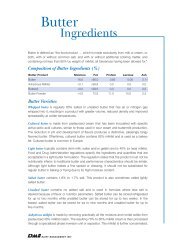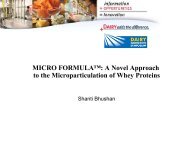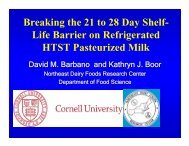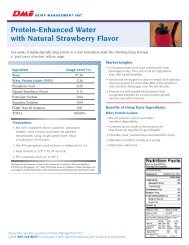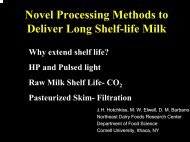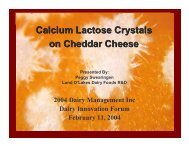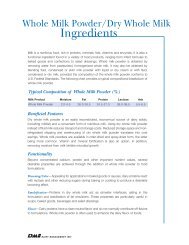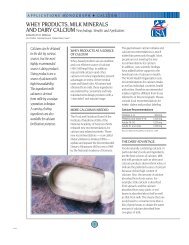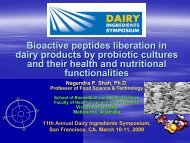Whey Protein Characteristics - InnovateWithDairy.com
Whey Protein Characteristics - InnovateWithDairy.com
Whey Protein Characteristics - InnovateWithDairy.com
Create successful ePaper yourself
Turn your PDF publications into a flip-book with our unique Google optimized e-Paper software.
protein aggregates were formed using water/oil microemulsions. These nanoparticles were immersed in various<br />
surfactants to produce a heat-stable transparent dispersion even in the presence of a high concentration of salt. 34<br />
Currently, scale-up research funded by the Dairy Research Institute is using various protein encapsulation approaches to<br />
produce solutions with 10 to 15 percent whey protein that are clear and heat-stable under severe processing conditions<br />
including retort at both acidic and neutral pH.<br />
Formation of Soluble Aggregates<br />
Recently published research examined the formation of soluble aggregates from WPI and β-lg. Solutions of 7 percent<br />
protein (buffered to pH 6.8) were heated to 90 C for 10 minutes and cooled in an ice bath for 10 minutes. 5 The native<br />
solutions and heated solutions of soluble aggregates were evaluated for their salt stability by <strong>com</strong>bining them with sodium<br />
chloride solution, diluting the protein concentration 3 percent. The salt/protein solutions were heat-treated again at 90 C<br />
for five minutes and cooled in an ice bath to room temperature. The whey-protein-soluble aggregates had increased heat<br />
stability in the presence of salt at neutral pH. The proposed mechanism is illustrated in Figure 3.<br />
Figure 3. 5<br />
Native <strong>Protein</strong><br />
Denatured/Partially Denatured <strong>Protein</strong><br />
Denatured <strong>Protein</strong><br />
Surface Hydrophobic Patch<br />
Surface Hydrophobic Patch<br />
- Negative<br />
Negative Charge<br />
Charge<br />
-<br />
-<br />
Native<br />
Add Add NaCl,<br />
∆Δ<br />
-<br />
-<br />
-<br />
-<br />
-<br />
Native<br />
Native<br />
∆<br />
- -<br />
-<br />
Soluble Soluble Aggregate<br />
Aggregate<br />
Add NaCl, Δ<br />
Add NaCl, ∆<br />
- -<br />
-<br />
Denatured proteins are present in whey protein isolate due to spray drying. Denatured proteins have exposed hydrophobic<br />
groups due to unfolding. The negative charges shown reflect the average charge of the proteins. The researchers propose<br />
that using soluble aggregates increases heat stability by reducing the aggregate size and modifying the shape of the<br />
aggregate. These changes reduce the turbidity and viscosity and increase the solubility of the final ingredient. Heating in<br />
salt solutions also lowers the potential for secondary interactions due to their higher negative charge, more <strong>com</strong>pact<br />
structure with less branching and small size.<br />
Formulating for Heat-stable Applications<br />
Improved whey protein heat stability can benefit multiple types of food and beverage applications. Many of the projects<br />
cited in this paper were designed with protein-enhanced beverages as a target for their work, and a basic understanding<br />
of formulating with whey proteins in beverages already has been published. 35 Despite this progress, protein beverage<br />
developers may have formulation challenges. It is the goal of whey protein researchers to develop technologies addressing<br />
stability issues created by whey proteins.<br />
34<br />
Zhang W, Zhong, Q. Microemulsions as nanoreactors to produce whey protein nanoparticles with enhanced heat stability by thermal pretreatment.<br />
Food Chem. 2010;119:1318-1325.<br />
35<br />
Rittmanic S, Burrington K. U.S. Dairy Export Council <strong>Whey</strong> Applications Monograph: U.S. whey proteins in Ready to Drink Beverages. 2006. Available at:<br />
www.usdec.org/files/Publications/BEVERAGESwebversion8-16-06.pdf. Accessed April 19, 2012.<br />
e3.11.77



